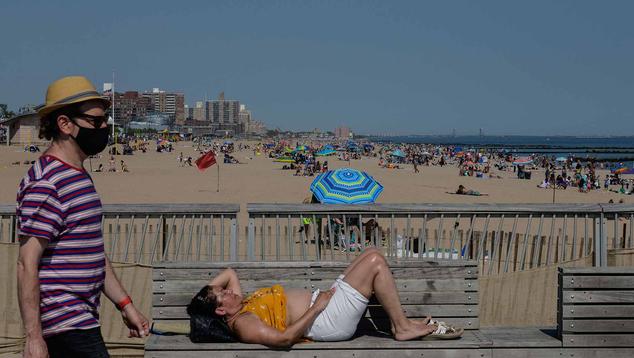Story Highlights
- 57% in U.S. say lives are "somewhat" back to normal; 9% "completely"
- For first time, majority think healthy people should lead normal lives
- Record-high 84% think coronavirus situation is getting better
WASHINGTON, D.C. -- Now that the majority of Americans aged 18 and older are fully vaccinated against COVID-19 and restrictions meant to curb the spread of the disease are increasingly being rolled back, two-thirds of U.S. adults (66%) say their lives are either "somewhat" or "completely" back to normal.
While this marks a sharp reversal from October when a majority said their lives were not yet back to normal, few Americans -- 9% -- say life is completely back to normal, while 57% describe it as somewhat normal. The remaining 34% say normalcy has not yet returned.
| Oct 2020 | May 2021 | Change | |||||||||||||||||||||||||||||||||||||||||||||||||||||||||||||||||||||||||||||||||||||||||||||||||
|---|---|---|---|---|---|---|---|---|---|---|---|---|---|---|---|---|---|---|---|---|---|---|---|---|---|---|---|---|---|---|---|---|---|---|---|---|---|---|---|---|---|---|---|---|---|---|---|---|---|---|---|---|---|---|---|---|---|---|---|---|---|---|---|---|---|---|---|---|---|---|---|---|---|---|---|---|---|---|---|---|---|---|---|---|---|---|---|---|---|---|---|---|---|---|---|---|---|---|---|
| % | % | pct. pts. | |||||||||||||||||||||||||||||||||||||||||||||||||||||||||||||||||||||||||||||||||||||||||||||||||
| Completely back to normal | 3 | 9 | +6 | ||||||||||||||||||||||||||||||||||||||||||||||||||||||||||||||||||||||||||||||||||||||||||||||||
| Somewhat back to normal | 34 | 57 | +23 | ||||||||||||||||||||||||||||||||||||||||||||||||||||||||||||||||||||||||||||||||||||||||||||||||
| Not yet back to normal | 62 | 34 | -28 | ||||||||||||||||||||||||||||||||||||||||||||||||||||||||||||||||||||||||||||||||||||||||||||||||
| Gallup Panel | |||||||||||||||||||||||||||||||||||||||||||||||||||||||||||||||||||||||||||||||||||||||||||||||||||
The latest findings are from Gallup's May 18-23 COVID-19 probability-based web panel survey.
Almost all demographic subgroups of the population show large shifts since last fall in reports that their lives are back to normal. Additionally, similar proportions of major subgroups now say their lives are completely or somewhat back to normal, including by gender, age, region, household income, parental status and employment status.
One exception to these general patterns is that Democrats (57%) are less likely than independents (68%) or Republicans (77%) to say their lives are at least somewhat back to normal. Republicans were much more likely than other groups in October to say their lives were at least somewhat back to normal (67%); therefore, the change in Republicans' opinions has been less dramatic than those for other groups.
| Republicans | Independents | Democrats | |||||||||||||||||||||||||||||||||||||||||||||||||||||||||||||||||||||||||||||||||||||||||||||||||
|---|---|---|---|---|---|---|---|---|---|---|---|---|---|---|---|---|---|---|---|---|---|---|---|---|---|---|---|---|---|---|---|---|---|---|---|---|---|---|---|---|---|---|---|---|---|---|---|---|---|---|---|---|---|---|---|---|---|---|---|---|---|---|---|---|---|---|---|---|---|---|---|---|---|---|---|---|---|---|---|---|---|---|---|---|---|---|---|---|---|---|---|---|---|---|---|---|---|---|---|
| Oct 2020 % |
May 2021 % |
Oct 2020 % |
May 2021 % |
Oct 2020 % |
May 2021 % |
||||||||||||||||||||||||||||||||||||||||||||||||||||||||||||||||||||||||||||||||||||||||||||||
| Completely back to normal | 8 | 17 | 2 | 10 | 1 | 2 | |||||||||||||||||||||||||||||||||||||||||||||||||||||||||||||||||||||||||||||||||||||||||||||
| Somewhat back to normal | 59 | 60 | 30 | 58 | 20 | 55 | |||||||||||||||||||||||||||||||||||||||||||||||||||||||||||||||||||||||||||||||||||||||||||||
| Not yet back to normal | 33 | 24 | 68 | 32 | 79 | 43 | |||||||||||||||||||||||||||||||||||||||||||||||||||||||||||||||||||||||||||||||||||||||||||||
| Gallup Panel | |||||||||||||||||||||||||||||||||||||||||||||||||||||||||||||||||||||||||||||||||||||||||||||||||||
Americans may be unlikely to say their lives are completely back to normal because a majority, 52%, still say their life is being disrupted by the coronavirus, including 14% who report "a great deal" of disruption and 38% "a fair amount." While still a majority, the current figure is well below the high point -- 81% -- from late March/early April 2020 polling, when much of the country was still living under state-issued stay-at-home orders.
Currently, 57% believe the disruption caused by the virus will continue through the end of 2021 (39%) or longer than that (18%). This is a smaller majority expecting protracted disruption than the 67% recorded in April. Meanwhile, 11% of Americans today expect the disruption to continue a few more weeks, while 31% say a few more months.
Majority Now Think Healthy People Should Lead Normal Lives
As a sense of normalcy returns, Americans have become less likely to believe that the best advice for healthy people during the pandemic is to stay home to help prevent the spread of the virus, dropping from 91% in March 2020 to 67% at the start of this year to 44% now. In fact, for the first time in Gallup's COVID tracking, a majority (56%) say the better advice is for people to live their normal lives as much as possible.
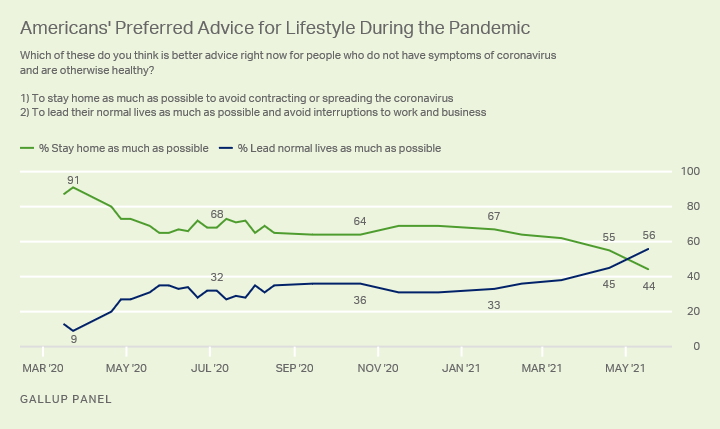
Line graph. Trend from March 2020 to May 2021 in Americans' view that the better advice for healthy people during the pandemic is to stay home as much as possible to avoid contracting or spreading the coronavirus, rather than to lead their normal lives as much as possible. The percentage recommending staying home as much as possible has declined from a high of 91% last March to 67% in January and is 44% today.
As seen previously, there is a substantial partisan divide on the advice question, with 87% of Republicans versus 64% of independents and 29% of Democrats recommending people should strive to lead their normal lives. Conversely, 71% of Democrats believe people should stay home as much as possible, although this is down from 85% in April.
Optimism About Coronavirus Situation Hits New High
An increasingly larger share of U.S. adults (84%) think the coronavirus situation is getting better, a 15-percentage-point increase since April.
February was the first time that a majority said the situation was improving, after majorities said it was worsening for much of last summer through the end of 2020.
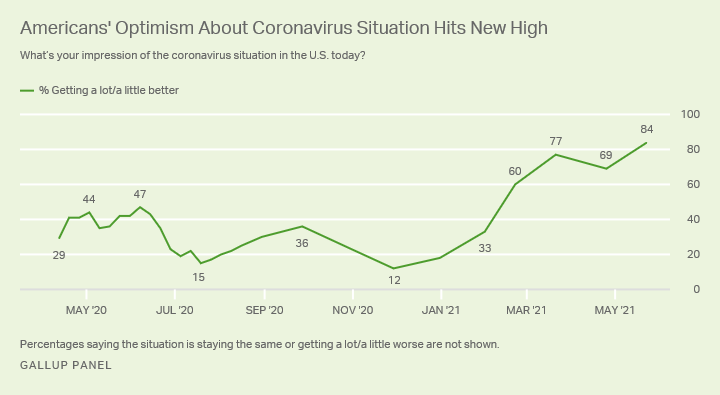
Line graph. Percentages of Americans who think the coronavirus situation in the U.S. is getting a lot or a little better since April 2020. Currently, 84% of U.S. adults say it is getting better, up from 69% in April and the highest on record.
Equal percentages now say the situation is getting "a lot better" as say "a little better," whereas the previous month twice as many said "a little better" as said "a lot better."
Currently, 11% in the U.S. say the situation is staying the same and 5% say it is getting "a lot" or "a little" worse.
Worry About Contracting COVID-19 at Lowest Point Since Beginning of Pandemic
Consistent with Americans becoming much more positive about the trajectory of the pandemic since January, their worry about contracting COVID-19 has decreased sharply over the same period.
The 20% of Americans who now say they are "very" or "somewhat" worried that they will get the disease is the lowest recorded over the past 14 months. This marks a 10-point drop in worry just since April and a 37-point drop since the end of 2020, when U.S. infections and deaths were spiking and the vaccine rollout was just beginning.
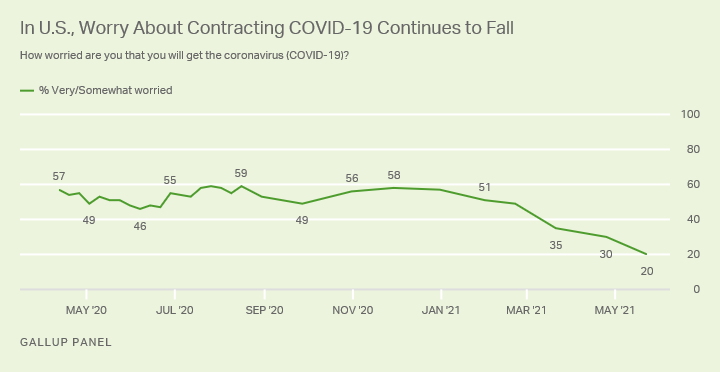
Line graph. Percentages of Americans who are very or somewhat worried about getting COVID-19 since April 2020. The latest 20% is the lowest on record, down from 57% late in 2020.
Satisfaction With Vaccine Rollout High; Leadership Ratings Less So
Americans are more pleased with the vaccine rollout now than at any point since it began, as 78% say they are "very" or "somewhat" satisfied. Satisfaction has steadily grown from 34% since late January.

Line graph. Americans' satisfaction with the COVID-19 vaccination process in the U.S. since January. Currently, 79% are either very satisfied or satisfied, up from 34% in January, 44% in February, 68% in March and 76% in April.
While Gallup does not directly ask the public whom they credit for the vaccination rollout, monthly coronavirus leadership ratings offer insight into how various players are perceived. Gallup has tracked Americans' ratings of state governors, the Centers for Disease Control and Prevention (CDC), and the president since last June for communicating a clear plan of action in response to the coronavirus.
Until President Joe Biden took office, state governors consistently received the highest marks for their communication of a clear pandemic response plan. Since his inauguration, however, Biden has far surpassed his predecessor, Donald Trump, and outpaced or tied state governors, while the CDC has the lowest ratings of the three for its communication.
Currently, 48% of U.S. adults agree that Biden has communicated a clear plan, while 45% say state governors have and 35% say the same of the CDC. The reading for the CDC is down six points since April, coming on the heels of its May 13 announcement that fully vaccinated Americans could remove their masks indoors. The new guidelines for mask use came as a surprise to many and reportedly led to some confusion among state government officials, business leaders and ordinary citizens.
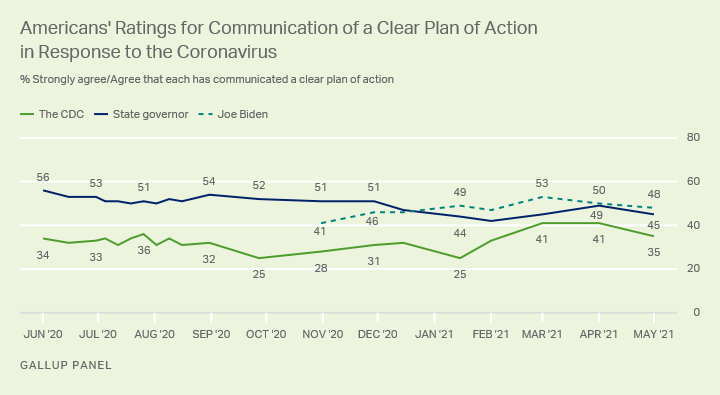
Line graph. Americans' ratings of the communication of a clear plan of action in response to the coronavirus by the CDC, state governors and Joe Biden. Ratings represent the percentages who agree that each has communicated a clear plan. The readings for the CDC and state governors began in June and Biden's began in October. The latest reading finds 48% agree Biden has communicated a clear plan, 45% say their state governors have and 35% say the CDC has.
Bottom Line
Americans' concern about the coronavirus has greatly diminished as the majority are now at least partially vaccinated, cases have been dropping, and state and local restrictions on public activity have been cut back significantly or removed completely. As such, Americans for the first time endorse healthy people living their lives as normally as possible, and many more say their lives are personally getting back to normal, if not completely so.
Still, the public does not believe the U.S. is completely past the pandemic, with the majority saying they are experiencing COVID-related disruption in their lives and close to six in 10 expecting such disruption to persist in the U.S. through the end of the year or longer.
Learn more about how the Gallup Panel works.
